Abstract
Isometric/isokinetic muscle strength and isokinetic endurance of the lower extremities as well as aerobic capacity were evaluated in 67 patients (43 female, 24 male; mean age 53 years, range 23-65) with classical/definite rheumatoid arthritis (RA) of functional class II. Results obtained were compared with those of a healthy reference group matched for age and sex. Disease characteristics of the group with RA were registered and lifestyle characteristics, such as work load, exercise, diet, smoking, and alcohol habits, were reported by both groups. Generally, results showed that the group with RA had decreased functional capacity. Isometric hip and knee muscle strength of the rheumatoid group was reduced to about 75% of normal function, isokinetic knee muscle strength at the velocities of 60 and 180 degrees/s to about 65% and 75% of normal function respectively, isokinetic endurance of the knee muscle groups to about 45%, and aerobic capacity to about 80% of the results obtained for the healthy reference group. Analyses of variance showed that the rheumatoid group, compared with the healthy group, had significantly reduced function on all isometric and isokinetic tests of the extensors and flexors of the knee. Results for isometric hip muscle strength were similar--all tests but one yielding highly significant differences. To avoid unnecessary functional deficits it seems important to include muscular training in rehabilitation programmes for patients with RA.
Full text
PDF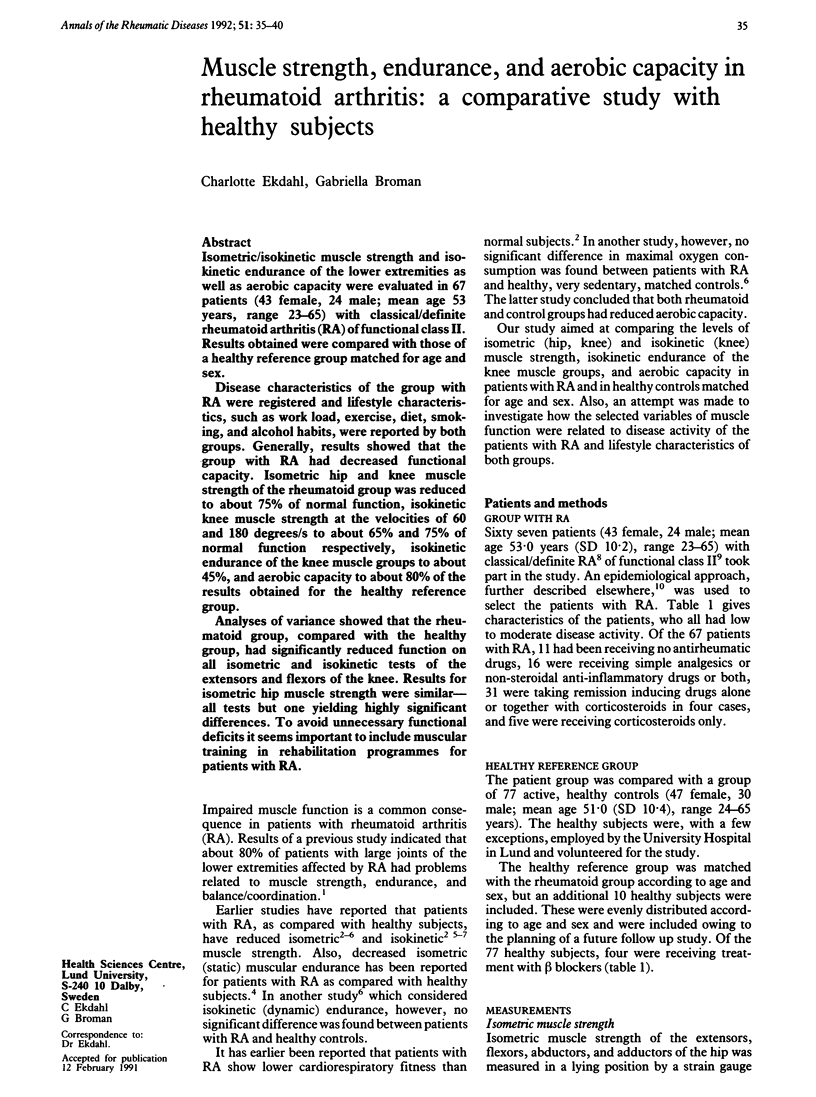

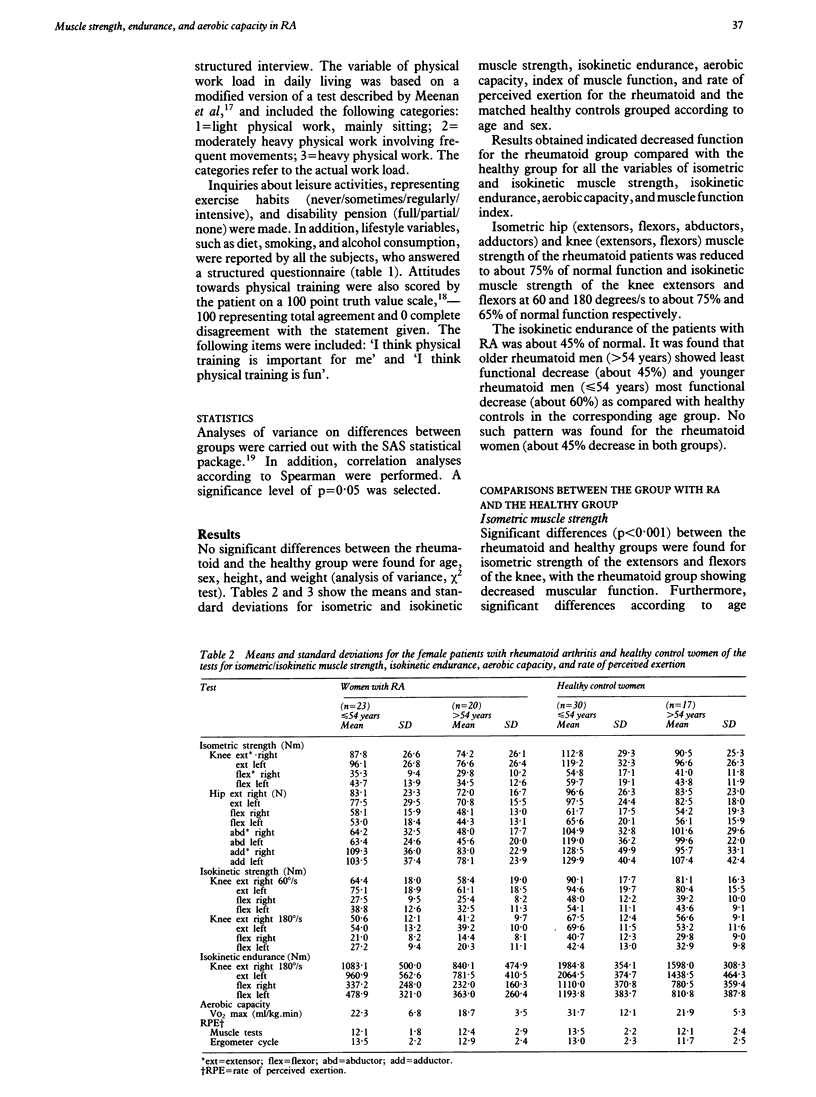
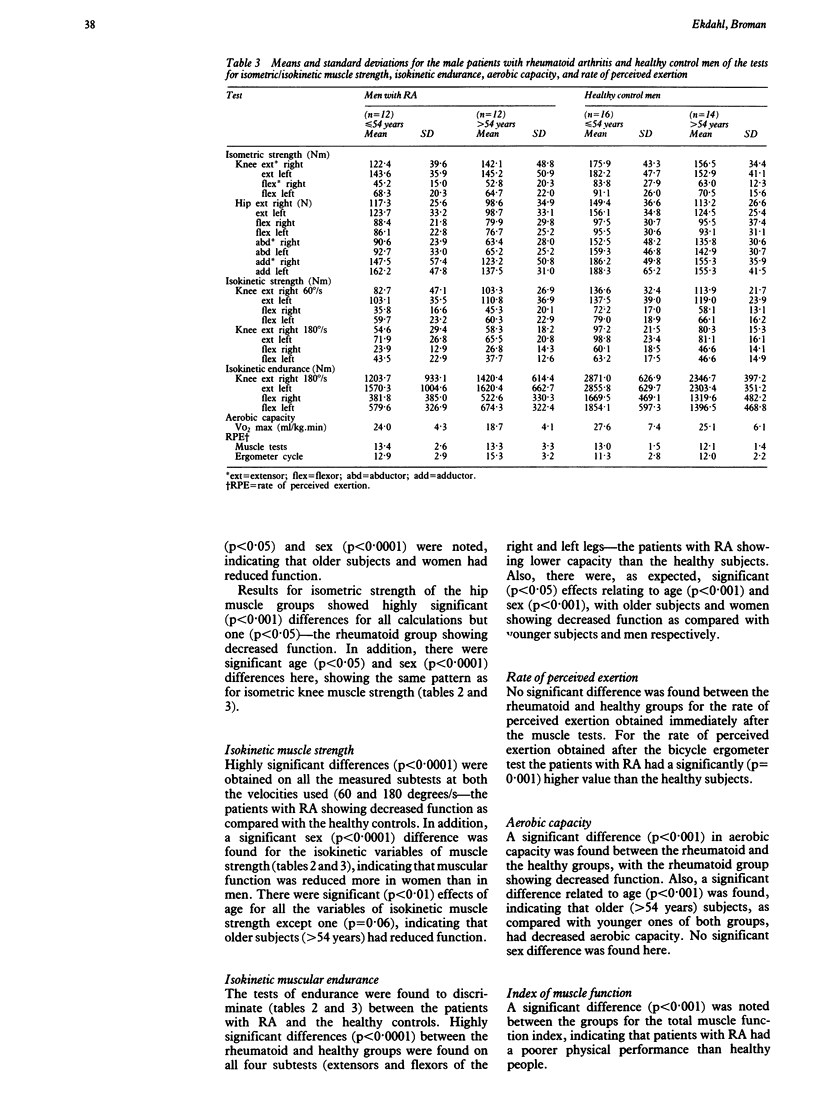
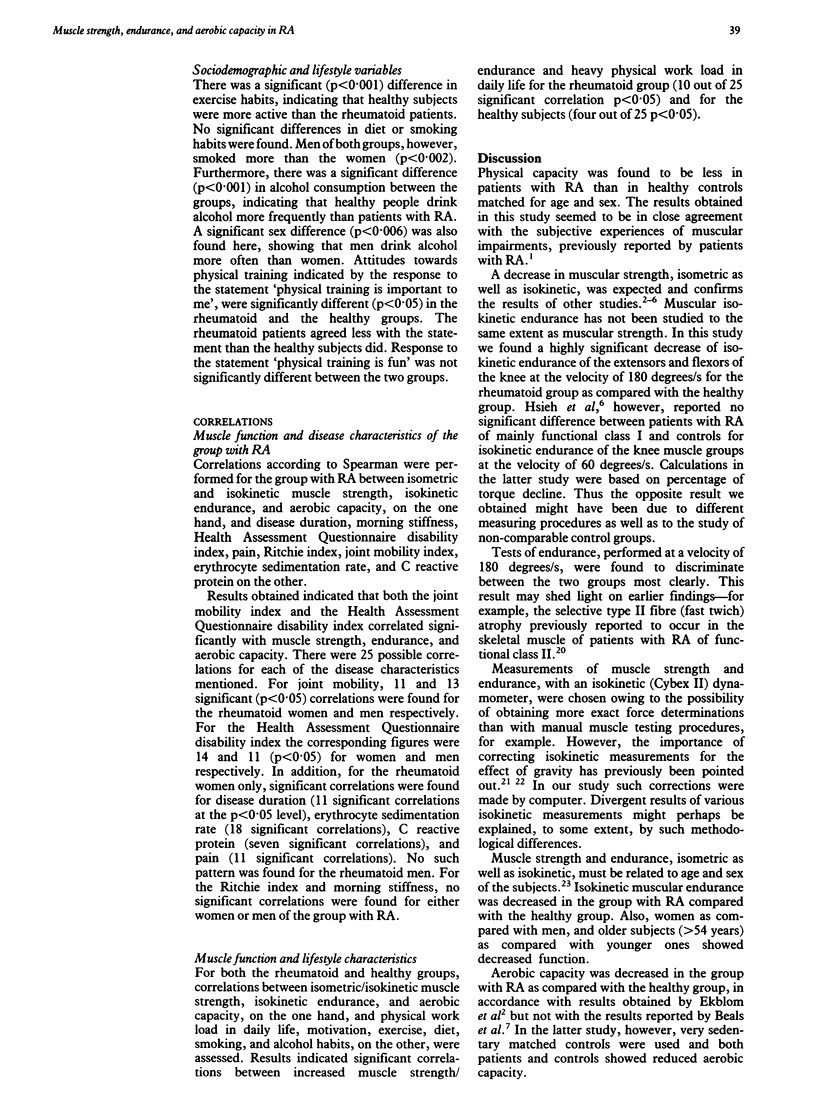
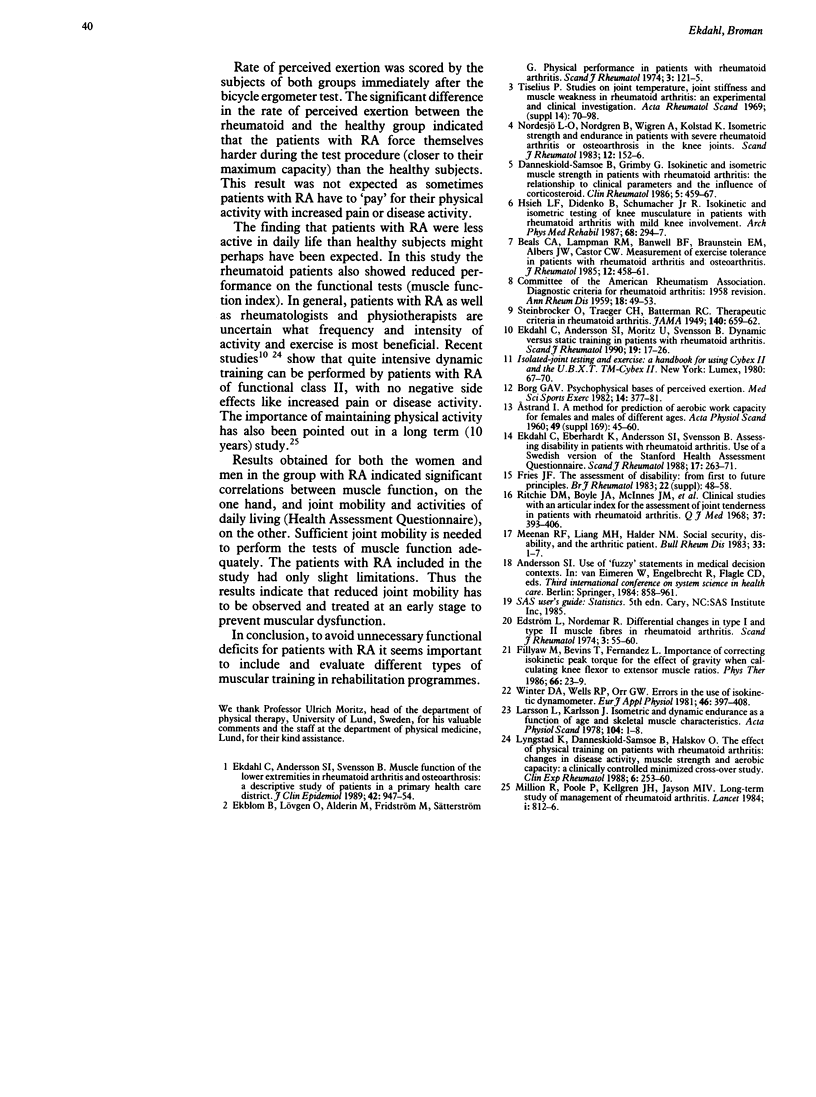
Selected References
These references are in PubMed. This may not be the complete list of references from this article.
- Beals C. A., Lampman R. M., Banwell B. F., Braunstein E. M., Albers J. W., Castor C. W. Measurement of exercise tolerance in patients with rheumatoid arthritis and osteoarthritis. J Rheumatol. 1985 Jun;12(3):458–461. [PubMed] [Google Scholar]
- Borg G. A. Psychophysical bases of perceived exertion. Med Sci Sports Exerc. 1982;14(5):377–381. [PubMed] [Google Scholar]
- Danneskiold-Samsøe B., Grimby G. Isokinetic and isometric muscle strength in patients with rheumatoid arthritis. The relationship to clinical parameters and the influence of corticosteroid. Clin Rheumatol. 1986 Dec;5(4):459–467. [PubMed] [Google Scholar]
- Ekblom B., Lövgren O., Alderin M., Fridström M., Sätterström G. Physical performance in patients with rheumatoid arthritis. Scand J Rheumatol. 1974;3(3):121–125. doi: 10.3109/03009747409097136. [DOI] [PubMed] [Google Scholar]
- Ekdahl C., Andersson S. I., Moritz U., Svensson B. Dynamic versus static training in patients with rheumatoid arthritis. Scand J Rheumatol. 1990;19(1):17–26. doi: 10.3109/03009749009092618. [DOI] [PubMed] [Google Scholar]
- Ekdahl C., Andersson S. I., Svensson B. Muscle function of the lower extremities in rheumatoid arthritis and osteoarthrosis. A descriptive study of patients in a primary health care district. J Clin Epidemiol. 1989;42(10):947–954. doi: 10.1016/0895-4356(89)90159-5. [DOI] [PubMed] [Google Scholar]
- Ekdahl C., Eberhardt K., Andersson S. I., Svensson B. Assessing disability in patients with rheumatoid arthritis. Use of a Swedish version of the Stanford Health Assessment Questionnaire. Scand J Rheumatol. 1988;17(4):263–271. doi: 10.3109/03009748809098795. [DOI] [PubMed] [Google Scholar]
- Fillyaw M., Bevins T., Fernandez L. Importance of correcting isokinetic peak torque for the effect of gravity when calculating knee flexor to extensor muscle ratios. Phys Ther. 1986 Jan;66(1):23–31. doi: 10.1093/ptj/66.1.23. [DOI] [PubMed] [Google Scholar]
- Fries J. F. The assessment of disability: from first to future principles. Br J Rheumatol. 1983 Aug;22(3 Suppl):48–58. doi: 10.1093/rheumatology/xxii.suppl_1.48. [DOI] [PubMed] [Google Scholar]
- Hsieh L. F., Didenko B., Schumacher H. R., Jr, Torg J. S. Isokinetic and isometric testing of knee musculature in patients with rheumatoid arthritis with mild knee involvement. Arch Phys Med Rehabil. 1987 May;68(5 Pt 1):294–297. [PubMed] [Google Scholar]
- Lyngberg K., Danneskiold-Samsøe B., Halskov O. The effect of physical training on patients with rheumatoid arthritis: changes in disease activity, muscle strength and aerobic capacity. A clinically controlled minimized cross-over study. Clin Exp Rheumatol. 1988 Jul-Sep;6(3):253–260. [PubMed] [Google Scholar]
- Million R., Kellgren J. H., Poole P., Jayson M. I. Long-term study of management of rheumatoid arthritis. Lancet. 1984 Apr 14;1(8381):812–816. doi: 10.1016/s0140-6736(84)92270-0. [DOI] [PubMed] [Google Scholar]
- Nordesjö L. O., Nordgren B., Wigren A., Kolstad K. Isometric strength and endurance in patients with severe rheumatoid arthritis or osteoarthrosis in the knee joints. A comparative study in healthy men and women. Scand J Rheumatol. 1983;12(2):152–156. doi: 10.3109/03009748309102902. [DOI] [PubMed] [Google Scholar]
- Ritchie D. M., Boyle J. A., McInnes J. M., Jasani M. K., Dalakos T. G., Grieveson P., Buchanan W. W. Clinical studies with an articular index for the assessment of joint tenderness in patients with rheumatoid arthritis. Q J Med. 1968 Jul;37(147):393–406. [PubMed] [Google Scholar]
- Winter D. A., Wells R. P., Orr G. W. Errors in the use of isokinetic dynamometers. Eur J Appl Physiol Occup Physiol. 1981;46(4):397–408. doi: 10.1007/BF00422127. [DOI] [PubMed] [Google Scholar]


